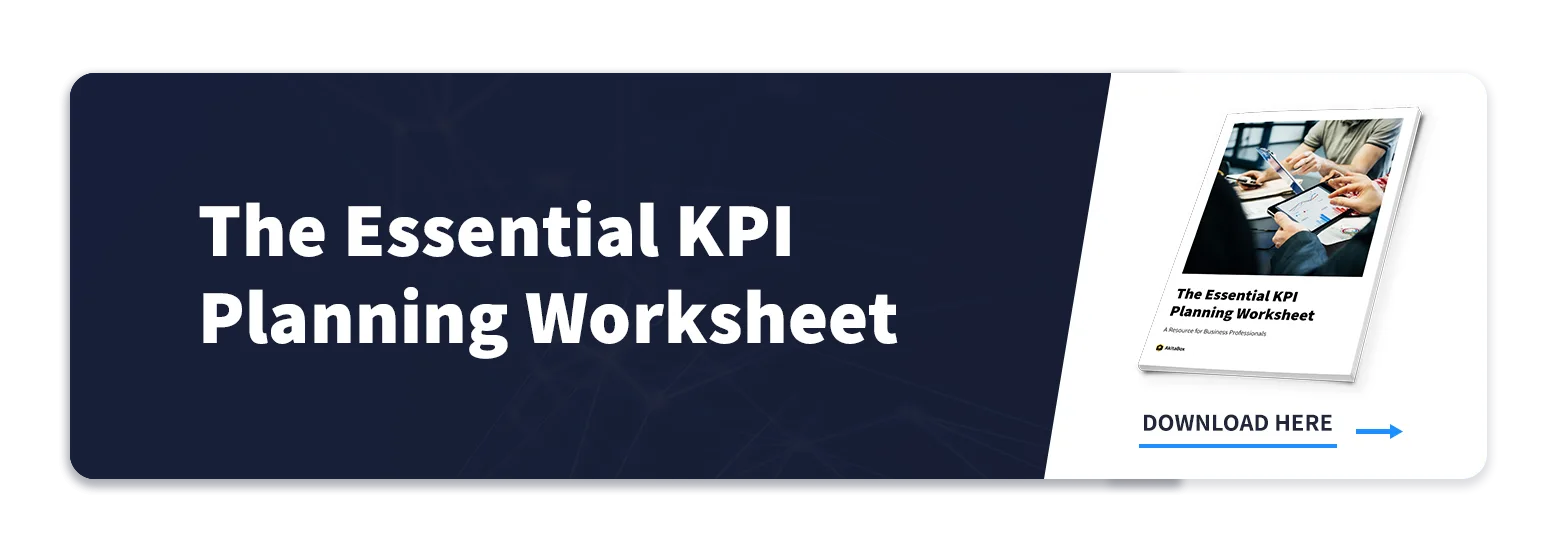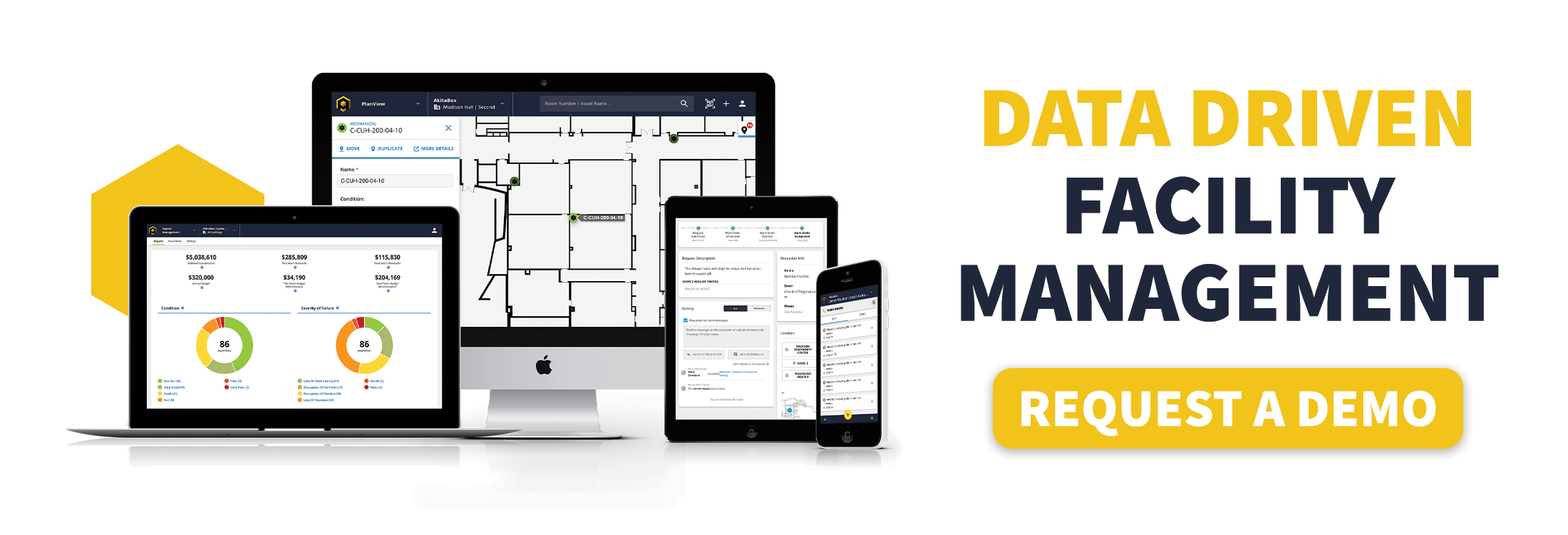Building data is powerful. It can be used to validate your facility team’s productivity and illuminate efficiencies that could help your organization retain profits over time. But the truth is: if you can’t measure it, you can’t manage it.
Read on to discover five critical steps to defining and tracking key performance indicators (KPIs) for one of your organization’s most valuable (and expensive) assets – your building infrastructure.
How to Set and Monitor Facility Department KPIs in 5 Steps
1. Understand the purpose of KPI measurement and reporting.
A key performance indicator (KPI) in facility management is a measurement used to track a team’s progress toward strategic goals. KPIs reveal performance data for specific team members and the department as a whole. These indicators will also support the organization’s overall goals and objectives.
Facility Management KPI Examples
Example #1: If an organization has an overarching goal of increasing revenue or profits, a facilities department can contribute to this goal by setting the following sample KPIs.
- Reduce maintenance costs by “X” percent
- Reduce energy consumption costs by “X” percent
- Reduce frequency of reactive maintenance by “X” percent
- Reduce premature asset failure by “X” percent
Example #2: If an organization has an overarching goal of increasing occupant satisfaction, a facilities department can contribute to this goal by setting the following sample KPIs.
- Achieve an “X:Y” ratio of reactive vs. preventive tasks completed
- Maintain an average of “X” hours to complete a work order
- Reduce environmental stressors (i.e. harsh lighting, excessive noise) by “X” percent
- Improve space utilization by “X” percent
2. Define which metrics you want to track to avoid data overload.
Building managers should meet with their organization’s executive team to identify which data points within their departments should be monitored. A facility department’s KPIs not only need to support the team’s goals, but also the organization’s goals as a whole.
To identify the most crucial data points that should be tracked with a KPI, facility managers should analyze building data and determine where the most time and money is being spent. The best KPI targets aim to improve areas of high value, so it’s important to direct attention and energy toward the most pressing areas of operation. That way, facility managers and their teams avoid undue stress, data overload and likely, a few choice words!
Insider Insight:
 |
“Effective business strategies are built around KPIs. Therefore, it’s important to ensure that building data is accurate, reliable and easy to access. A robust facility management software can be used to track, monitor and gain valuable data and insights into KPI progress. Having real-time building operations data from facilities departments allows the C-suite to focus on underperforming parts of their portfolio, driving the true bottom line for the board of directors.”
Derek Blackmore, President at AkitaBox
|
3. Ensure that your KPIs are realistic and achievable.
Leaders can work with their facility teams to make overarching goals more attainable by setting small, achievable steps along the way. For example, a KPI target of “increasing maintenance efficiency by ‘X’ percent” may seem lofty, but setting smaller goals will make this objective more attainable.
As an example, a maintenance team could work toward achieving this goal by 1) monitoring room usage, 2) dispatching maintenance crews only as needed and 3) taking a more proactive approach to maintenance. Increased maintenance efficiency will ultimately contribute to the organization’s goals, such as saving on costs, improving occupant satisfaction and boosting employee retention.
- FREE Downloadable Content: When determining your KPIs, focus on future standards and not past performance. Future goals must be realistic, or you’ll run the risk of poor results, frustrated leadership and disgruntled occupants. Stay on the right track when planning KPIs by downloading the Key Performance Indicator (KPI) Planning Worksheet.
4. Follow the “S.M.A.R.T.E.R.” approach to KPI management.
When it comes to goal setting, one of the most common mistakes that facilities teams can make is failing to measure the goal’s progress. The “S.M.A.R.T.E.R.” approach to goal setting alleviates this problem and makes initiatives easier to tackle.
For each KPI target, follow these steps to ensure success.
- “Specific” – Objectives need to be specific. List the exact steps your facilities department will need to take to achieve the goal. Lastly, quantify your success through departmental data.
- “Measurable” – Find a definitive way to measure the data that needs to be recorded. There should only be one effective method of measurement – an essential aspect of KPI management.
- “Attainable” – Short-term goals should be within reach, but not so easily attainable that they won’t take much work or effort. Small successes will help teams build momentum towards long-term goals.
- “Relevant” – KPI targets should be simultaneously relevant to the department’s and organization’s goals. Objectives should have a positive impact on occupants, staff and visitors within your building.
- “Time-bound” – Create a timeframe and deadline for each KPI target. When goals are time-bound, they’re measurable and hold the facilities team accountable for getting things done on time.
- “Evaluate” – Ensure that facilities KPI goals are evaluated on a daily, weekly or monthly basis. Regular evaluations will increase the team’s likelihood of achieving the KPI goal.
- “Re-evaluate” – The final step is to re-adjust the approach to achieving KPI goals, if applicable. Test for consistency before regular implementation. Re-evaluation will lead to increased progress.
5. Use a facility management software to manage KPI data reporting.
Facility management software is a critical tool used for benchmarking, measuring and tracking your facility department’s performance as well as your building’s operational efficiency. Data is displayed on a maintenance reporting dashboard, giving facility managers a visually-engaging view of their department’s data. This data is passed on to administrative and leadership teams, who can leverage this data to justify funding and hiring decisions.
Facility management software tracks essential data for not only facilities teams, but also for executive decision-makers within an organization. Here are examples of statistics that the right software can track.
- Number of service requests submitted/completed
- Average resolution time per service request
- Average work orders completed per day
- Average hours logged per work order
- Average work order duration (in hours)
- Number of work orders opened
- Number of work orders completed
- Ratio of opened vs. closed work orders
- Ratio of reactive vs. preventive work orders
The most successful facility managers use the above-mentioned facilities data to make informed decisions that drive their organizations forward. Choose a software that offers facility data visualizations that are clear, concise and prove your facility department’s hard work throughout the year.
Discover the Industry’s Leading Software for Real-Time Maintenance Reporting
An organization’s building KPIs rely on accurate data, so ditch the spreadsheets and pen-and-paper management methods and invest in intuitive facility management software for your team.
The Benefits: The right platform allows technicians to update and complete work orders with the click of a button. The team will receive up-to-date maintenance reports in real-time. Not only will you be able to better understand building data, you’ll also gain additional insight into work by assignee, maintenance type or trade. This data is crucial to setting realistic, attainable goals for facilities teams.
Ready to learn more? Click the image below to see how software can help manage facility management KPI data.


